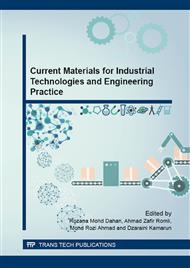p.61
p.66
p.70
p.75
p.82
p.88
p.96
p.103
p.109
Analysis of Micro-Porosity Defect and Remedial Measures in Crankshaft (Ductile Iron) – A Case Study
Abstract:
This paper presents analysis of Micro-Porosity defect in product Crankshaft - Ductile cast iron (FCD 700/2), which has been carried out at one of Automotive Foundry Company in Malaysia. Systematic analyses like cause-effect diagram and defect diagnostic study approach were carried out to understand the root causes of the micro-porosity. From the data analysis there are two significant factors are identified that affect the formation of micro-porosity, they are mold factor and metal factor. Four remedial countermeasures have been proposed to prevent micro-porosity; increase squeezes pressure at molding machine, control sand moisture, increase radius at edge of mold, and reduce Magnesium (Mg) content. Result of the trials showed substantial reduction of micro-porosity defect in crankshaft (casting). The company has accepted the countermeasure and incorporated in the standard operation procedure.
Info:
Periodical:
Pages:
82-87
Citation:
Online since:
December 2015
Price:
Сopyright:
© 2016 Trans Tech Publications Ltd. All Rights Reserved
Share:
Citation:


